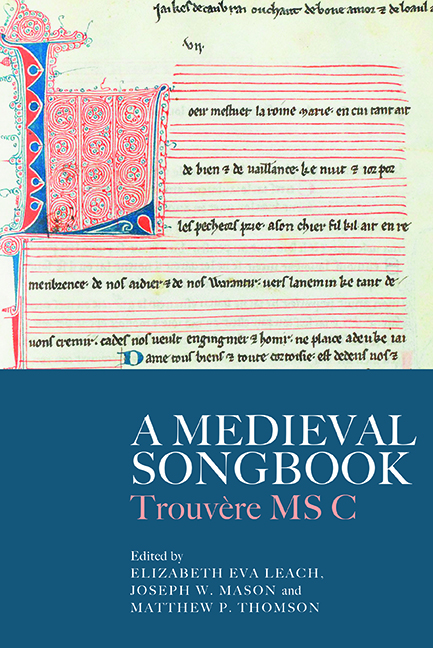Book contents
- Frontmatter
- Contents
- List of Illustrations
- List of Music Examples
- List of Tables
- List of Contributors
- Acknowledgements
- Abbreviations
- Editorial Practices
- Introduction
- Chapter 1 The Trouvère Manuscripts of the Burgerbibliothek Bern
- Chapter 2 The Lorraine Repertoire of C
- Chapter 3 Chansonnier C: Contents, Stemmatic Position, Particularities
- Chapter 4 A Note on the Decoration of C and its Artistic Context
- Chapter 5 Author Ascriptions and Genre Labels in C
- Chapter 6 Common Exemplars of U and C
- Chapter 7 Shared Small Sources for Two Early Fourteenth-Century Metz Chansonniers?
- Chapter 8 The Legacy of Thibaut de Champagne in C
- Chapter 9 Strategies of Appropriation in Jacques de Cambrai's Devotional Contrafacts
- Chapter 10 Jeux-Partis and their Contrafacts in C
- Chapter 11 C and Polyphonic Motets: Exemplars, Adaptations, and Scribal Priorities
- Appendix: List of Songs in C
- Bibliography
- Index of Sources
- Index of Songs
- General Index
- Studies in Medieval and Renaissance Music
Introduction
Published online by Cambridge University Press: 26 May 2022
- Frontmatter
- Contents
- List of Illustrations
- List of Music Examples
- List of Tables
- List of Contributors
- Acknowledgements
- Abbreviations
- Editorial Practices
- Introduction
- Chapter 1 The Trouvère Manuscripts of the Burgerbibliothek Bern
- Chapter 2 The Lorraine Repertoire of C
- Chapter 3 Chansonnier C: Contents, Stemmatic Position, Particularities
- Chapter 4 A Note on the Decoration of C and its Artistic Context
- Chapter 5 Author Ascriptions and Genre Labels in C
- Chapter 6 Common Exemplars of U and C
- Chapter 7 Shared Small Sources for Two Early Fourteenth-Century Metz Chansonniers?
- Chapter 8 The Legacy of Thibaut de Champagne in C
- Chapter 9 Strategies of Appropriation in Jacques de Cambrai's Devotional Contrafacts
- Chapter 10 Jeux-Partis and their Contrafacts in C
- Chapter 11 C and Polyphonic Motets: Exemplars, Adaptations, and Scribal Priorities
- Appendix: List of Songs in C
- Bibliography
- Index of Sources
- Index of Songs
- General Index
- Studies in Medieval and Renaissance Music
Summary
The present volume brings scholarly perspectives from a variety of disciplines to bear on a specific medieval object: a beautifully produced parchment manuscript, now in Bern, Switzerland, containing over 500 songs. The first stanza of each song is carefully copied beneath staves for their melodies, but the planned musical notation was never entered. Despite the intriguing poignancy of the empty staves for musicologists, their muteness has led to the relative neglect of Bern, Burgerbibliothek, Cod. 389, known to scholars of trouvère song by Schwan's siglum C. After all, what can a musicologist say about a song when only the text survives?The lack of notation is the first of several factors that has led to the relative scholarly neglect of C, including its provenance on the easternmost border of the Francophone region, its choice not to organise by author corpora, its comparatively high numbers of unica, and the absence of illuminations.
C has thus been perceived as distant from a ‘central’ trouvère tradition embodied by the surviving authorially organised and richly illuminated manuscripts that hail largely from the Artois and Champagne; the supposedly problematic aspects of C have combined in various ways to cause C's neglect not just in musicology, but also in other academic disciplines that study trouvère song. Although literary scholars have considered C more deeply than their musicological colleagues, they have typically done so in conjunction with the creation of editions of the texts of specific authors or edited collections of predominantly anonymous secondary genres, like the pastourelle. C's eastern provenance has meant that the variants that it presents for those songs with concordances in other, more ‘central’ sources have been noted in the apparatus of critical editions, but largely relegated to a secondary status: indeed, some of the authorial songs in C have themselves been treated as of secondary authenticity within their respective author corpora. The high number of unica in C – over 20% of its contents – have all now been edited, but not yet thoroughly integrated into literary scholarship; that so many of C's songs are not also found in other sources has reinforced the impression of C as a peripheral source.
- Type
- Chapter
- Information
- A Medieval SongbookTrouvère MS C, pp. 1 - 12Publisher: Boydell & BrewerPrint publication year: 2022

